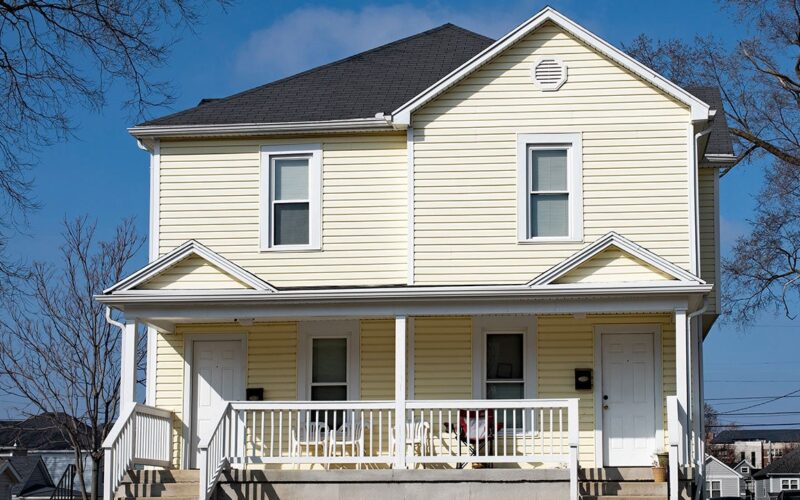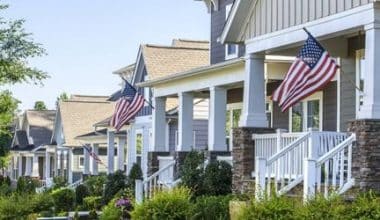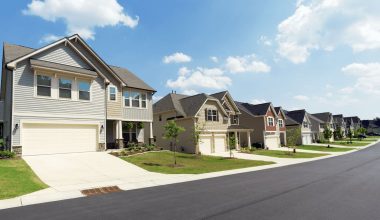Investing in a multi-family home can be a great way to get started as a real estate investor and a great means to earn passively. Due to the fact that multifamily properties are in such great demand now, the financial rewards will also be equivalent to that demand. However, what exactly is a multifamily house, and how can you tell if it’s the ideal investment for you? In this article, we will explain what a multifamily home is, the difference between buying and building a multi-family home if you can buy a home with an FHA loan, and the different multi-family home loans.
What Is a Multifamily Home?
A multifamily home is a single structure designed to house multiple families living apart. This can include a duplex (two houses in one building), single-family homes, or small apartment buildings with up to four units. (Commercial properties are known as buildings with more than four units.)
The landlord of a multifamily home has the option of living in one unit and renting out the others, or living on another property and renting out all of them. You’re considered an investor if you don’t reside in the property, and the conditions for receiving a mortgage are different. You might be able to maximize the property’s predicted rental revenue to help you qualify for a mortgage, and you might be able to get a bigger loan.
“When you’re looking at a single-family home, you’re thinking about your own needs only,” explains Charlotte Winckowski, a sales associate with Re/Max Central Group in Toledo, Ohio. “When you’re looking at a multi-family home, you have to think of it more as a business: What will the needs of your tenants be? What kinds of income will it produce and what will your expenses be?”
Here’s a rundown of some of the different types of a multifamily home
#1. Duplex
A duplex is a two-story dwelling where each floor houses a different family. Although they will share a front door, each unit will have its own entrance.
#2. Townhouse
Two families share one house in a townhouse, divided by an inner wall. Both families buy their homes independently, and each has its own entrance.
#3. Apartment Complex
A multi-unit apartment complex is a single building with at least five different units. Residents frequently share resources, such as a swimming pool, parking garage, or playground.
#4. Semi-detached House
A semi-detached house is a single-family dwelling with a shared wall with another property. They resemble townhouses in appearance.
Multi-Family Home vs Single-Family Home
There are a few major differences between investing in a single-family or multifamily home.
Price
The price will be the most significant difference. A single-family home is a less expensive and simpler way to begin investing in real estate.
Mortgage
For a single-family home, you might likely get a conventional mortgage. A multifamily property, on the other hand, will almost certainly require a commercial real estate loan. And, particularly if you’re new to real estate investment, lenders will almost certainly need a 20% down payment.
Risk
Single-family homes are also easier to sell. So you don’t have to worry about
Scalability
A multifamily property, on the other hand, is easier to scale and yields a bigger monthly cash flow. It’s also less difficult to try “house hacking” on a multifamily home. This implies that you reside in one unit while renting out the others.
Privacy
Because of shared walls, those who live in multi-family houses may have less privacy than those who live in single-family homes.
Pros and Cons of Living or Investing in a Multi-Family
Investing in multifamily properties has both benefits and drawbacks. Investors should make sure this type of property suits their budget and requirements. Let’s start with some of the most important advantages and disadvantages to examine.
Pros of a Multi-Family Home
- The rental income generated by your home can be used to assist offset the cost of your mortgage and other housing expenditures, thereby providing you with a regular source of income.
- It will be easier to deal with repairs and maintenance. It’s less likely that you’ll notice severe difficulties if you live in or near your rental home, and you’ll be able to respond more quickly if problems emerge.
- Much of your house maintenance can be written off as a business expense, and you can prorate some of your mortgage interest payments.
- It’s a great alternative for multi-generational families who wish to be close while still maintaining their privacy (or helps you keep the option open in the future).
- You can keep the property as an income-producing investment even if you eventually move out and into your own house, earning even more if you start renting out your old flat.
Cons of a Multi-Family Home
There are drawbacks to buying a multifamily home, just as there are with any rental property. The following are the most significant disadvantages to consider:
- Buying a multifamily home may cost more upfront than buying a single-family home because you’re buying multiple units.
- To be a landlord requires dedication and time, and living with your tenants means from time to time, you are likely to be disturbed by the knocks of your tenants on your door with maintenance or repair problems. You’ll also need to make sure you’re confident in your ability to negotiate lease conditions and screen tenants.
- You’re still liable for paying your mortgage whether your units are vacant or if a tenant is late with their rent. You must also account for the cost of (soon) addressing issues
- You’ll require a significant emergency fund. The more units you have, the less an individual property will affect your total cash flow; however, landlords should set aside an emergency fund to handle unforeseen repairs and rent on vacant units.
- Selling a multi-family property with tenants might be more difficult because you’ll need to organize showings and appraisals as well as keep the tenants informed about the process.
- When the rent is past due, there are noise complaints, or the property is damaged, to name a few challenges that landlords may confront, you must be able to deal with renters in a professional manner.
Maximizing Multifamily Home ROI
A multifamily home is almost always used as an investment property by the owner. Real estate is still the most popular long-term investment option in the United States. It’s crucial to understand all of the costs involved with the property, including not only your mortgage, property taxes, and homeowners insurance, but also utilities, real estate agent fees, advertising (to attract tenants), and legal fees, in order to get the most out of your investment.
What To Look For When Buying A Multifamily Home
Certain key characteristics of any multifamily unit make it a good investment. Before buying a new property, potential investors should contact a certified real estate agent concerning properties in their region.
The Following are some of the most important things to look for:
#1. Locations
One of the most important factors determining how simple it is to locate tenants is the location of the property. It will also impact the amount of rent you can charge. make research to find a property in a desirable area.
#2. Potential Rental Income
What kind of rental income can you expect to make? You may need to calculate how much you’ll need to earn to cover the mortgage, probable repairs, and other expenses to find out your potential rental income.
#3. The number of units
The more apartments the property has, the more prospective tenants you have. Determine the desired number of units based on your budget and the amount of money you want to make.
#4. Property Seller
Finally, you should conduct research on the person selling the property. Do they have a track record for maintaining the property?
Determining if You Qualify for Multifamily Home
Before you begin the purchasing process, you need to determine whether or not you are eligible for a mortgage on a multifamily property. It is necessary to consider the following factors when purchasing a 2- to 4-unit multifamily property, the kind of which may be obtained from many residential lenders
Step by Step Guide to Buying a Multifamily Home
In order to successfully purchase multifamily properties, it is important to have a solid understanding of where to begin, how to choose a loan type, and what involves making a strong offer.
From the following, we’ll take a closer look at the multifamily home buying process and how you may improve your chances of spotting and seize on new opportunities in the process.
#1. Find A Multi Family Home
For starters, when purchasing a multifamily home, you’ll want to look for a property that has its situation in a neighborhood that will be the most accessible to tenants in the future. In your search for rental units and properties, keep an eye out for neighborhoods with quality school districts, developing neighborhoods, and towns with a high concentration of tourist attractions and destinations that have surviving potential. Because, after all, a desirable location attracts high-quality tenants who are willing to pay a premium to reside in the property.
You will also need to work with a local realtor. They can help you decide where to buy and whether a house is expensive.
You should also perform your own study on the location, especially if you are unfamiliar with it or do not reside nearby. This may entail visiting a neighborhood multiple times on different days to properly understand its character. A little research can save you from buying in a terrible area.
#2. Choose a Loan
When buying a multifamily home, it’s crucial to know which financing program and supplier to use. Anyway, successful property investment involves acquiring the best possible interest rate, controlling cash flow, and considering how different asset categories blend into your total investment portfolio.
One factor to bear in mind is that certain online lenders will only finance two-unit properties. This form of investment is perfect for landlords who wish to manage multiple multifamily properties or for those who want to live in one apartment and rent out the other for extra income.
Otherwise, conventional mortgages/loans are the most popular option for multifamily home buying investment. You may be eligible for an FHA or VA loan through several mortgage companies, if one of the apartments is your main residence,
Once you’ve secured finance, you’re ready to make an offer.
#3. Make An Offer
When placing an offer on a multifamily property, you’ll want to consult your agent. Before your agent meets with the selling agent on your behalf, consider the highest offer you’re willing to make (based on your budget and financing limits).
Your agent will then meet with the seller’s agent to negotiate. Your bid to acquire the multifamily property might be accepted. Counteroffers are normal, so don’t get disappointed if you have to renegotiate several times.
After the seller accepts your offer, the closing procedure begins. Purchase insurance, schedule an inspection and handle closing costs now.
#4. Renovate and Get Ready for Your Tenants
After closing, you can start renovating your new multifamily property and preparing for renters. This process includes renovating/repairing and drafting a management strategy.
Repair And Renovate
Before you can start renting out units, check sure your multifamily home meets municipal codes.
You may also want to replace doorknobs, light fixtures, cabinet pulls, and paint. Remember that these renovations may help you lure more tenants, raise the rent, and increase overall net operating income.
Make sure you have a maintenance strategy. This plan should include tenant repair requests, building maintenance, grass care, and snow removal.
Create a Management Plan
Finally, you must decide how you will manage your multifamily rental apartments and advertise to potential tenants. Before making this choice, consider how much time you can devote to your property.
As part of your planning, you should create a budget for your multifamily property that accounts for running expenses, upgrades, and cash flow demands.
Multifamily Home Loans
Multifamily home loans allow investors to buy or refinance properties with two to four units or five or more units. Also, multifamily home loans offer cheap rates and periods up to 35 years for both new and experienced investors.
There are four forms of Multifamily home loans:
#1. Conventional Multifamily Home Loan
Suitable for investors seeking standard multifamily financing for two to four units in good condition.
#2. Government-backed Multifamily Home Loans
Government-insured multifamily home loans are best for investors with five or more units or owner-occupants of two- to four-unit properties like Fannie Mae, the Federal Home Loan Mortgage Company (Freddie Mac), or the Federal Housing Administration (FHA).
#3. Portfolio Multifamily home Loan
This loan is ideal for investors who wish to finance many properties but are not eligible for regular loans.
#4. Short-term multifamily home loan
Fix-and-flip investors that want to buy a problematic property quickly will benefit from short-term multifamily financing.
Benefits of Building a Multifamily Home
Building a multifamily home is an alternative to acquiring one. The approach and analysis are radically different when looking at building a multifamily home. Rather than worrying about producing a profitable multifamily investment, investors can determine the layout and qualities of the building.
Building a multifamily home from the bottom up means everything will be completely new, and you won’t have to worry about out-of-date styles, limited infrastructure, outdated wiring, or other future problems.
When building a new multifamily home, you have the option of selecting the location, amenities, and cutting-edge technologies, as well as using creative construction processes. Another advantage is that you get to choose the location for your new structure.
Considering rising property values over a period of time, a brand new apartment means you can demand top dollar rents. While building a multifamily home from the bottom may cost more initially, it will pay off in the long run, saving you money and allowing you to earn a higher return.
Can I Buy a Multifamily Home With an FHA Loan?
FHA loans are a federally supported program that allows individuals with a low down payment, bad credit, or other financial challenges to purchase a home. “Can FHA loan(s) be utilized to buy a multifamily home?” is a frequently asked question.
In brief, FHA loan(s) can be used to buy a multifamily home, but there are some requirements. When a buyer intends to live in only one unit of a multifamily home, they may be eligible for an FHA loan.
For FHA loans to be used to buy a multifamily home, the following requirements must be met
- The borrower must reside in the property as their main home for a minimum of one year.
- The main house must be occupied within a certain period of time stipulated by the lender.
- A multi-family unit containing up to four units.
- The property must meet FHA loan(s) requirements to buy a multifamily home.
When considering a loan for a multifamily property, the bank may take into account other criteria such as the debt-to-income ratio after bringing in rent and whether the borrower has previously been a landlord.
Other non-loan considerations include local landlord legislation, the time and money commitment of renting out a property, and other due diligence to ensure the property is the perfect fit for you. Other non-loan considerations include local landlord legislation, the time and money commitment of renting out a property, and other due diligence to ensure the property is the perfect fit for you.
Conclusion
Buying and building and later renting out a multifamily home have numerous advantages and disadvantages. However, it’s a brilliant way to get your estate investment career up and running, and you can even live in one of the units. Nevertheless, it will require a significant amount of your time and money, so make sure you’re up to the task.
FAQs
What is considered a multifamily home?
A multifamily home is a structure that allows you to make money from multiple properties within the same house. This can consist of an apartment building, a triplex, or even a townhouse.
How much does it cost to build a multi-family home?
When considering the building of a multifamily home, there are numerous expenses to consider. Eg, land cost, architecture fees, contractor fees, plumbing, electrical work, painting costs.
Can I buy a multifamily home with a fha loan?
An FHA loan can be used to buy a multifamily home, but there are some requirements.
What should i look out for when buying a multifamily home?
When buying a multifamily home, you should look out for factors like location, potential rental income, number of units, and property seller






